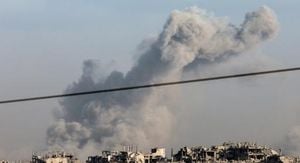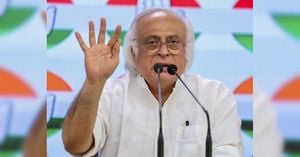The Russian ruble has demonstrated significant strength against the US dollar, marking its lowest exchange rate since November 2024. On February 12, 2025, the official exchange rate set by the Central Bank of Russia (CBR) stood at 95.8024 rubles per dollar, down from 96.7821 rubles the previous day. This downward trend has captured the attention of analysts and market experts alike, as the ruble continues to appreciate, reflecting various economic factors at play.
Financial analyst Mikhail Belyaev attributes the recent ruble strength to several market dynamics. According to Belyaev, "Currently, the dollar rate has reached its minimum; it should not fall below 95 rubles per dollar," indicating his belief not only in the current trends but also implying upcoming economic shifts.
Several factors have contributed to the strengthening of the ruble. Analysts from RBC highlight low currency demand among consumers and businesses, the normalization of currency revenue inflows, high domestic interest rates, and favorable prices on global oil markets as key elements. The strengthening of the ruble reflects broader economic conditions influenced by both external factors and internal monetary policy.
On February 12, the dollar also traded below the psychologically important level of 96 rubles, with reports indicating the dollar had depreciated around 5% against the ruble since early February. The dip to below 95 rubles is particularly significant, marking the first time since early November 2024 when the dollar was valued so low against the ruble.
Experts like Alexander Shepelev from BCS Mira Investments note, "We see seasonally strong balance of payment figures, consistently high energy prices, and increased currency sales by Russian companies," all of which bolster the ruble's position. This strengthening trend is accompanied by reduced requirements for imported currency, as anticipated lower import volumes may contribute to less demand for foreign currencies.
Insights concerning the CBR's role are also noteworthy. After implementing changes to how it calculates currency exchange rates, the CBR has moved toward considering combined data from both the stock market and over-the-counter transactions. By adjusting the official rates to reflect market conditions and currency sales, analysts suggest the CBR is strategically reinforcing the ruble's position.
Belyaev's observations highlight the economic outlook for Russia as potentially subdued, with expectations for low growth rates persistently looming. The subdued economic forecasts might eventually lead to the ruble experiencing pressure against major currencies. Echoing recent trends, Belyaev states, "The ruble's current appreciation can be attributed to several favorable factors, but sustained growth may face challenges." This assessment underpins broader discussions about currency fluctuations within fluctuated economic conditions.
Notably, the CBR's interventions signify confidence as it maneuvers within the financial marketplace to stabilize the ruble. The fluctuations seen lately may reflect immediate responses to market pressures, geopolitical apprehension, and national monetary policy strategies. Russia's broader economic climate remains at the forefront, as the interplay between geopolitical situations, energy prices, and overall economic activity play pivotal roles.
The situation remains dynamic, with potential for shift as traders anticipate changes born from budgetary pressures and external economic influences. Overall, the ruble's strength against the dollar, underlined by macroeconomic factors and the CBR's active strategies, presents both opportunities and challenges. Speculation surrounding currency performances highlights the importance of watching trends, especially with forecasts indicating cautious optimism tempered with reality checks.
Given all developments, observers are drawn to both the mechanics behind currency valuations and the larger economic narrative steering Russia's financial direction. Following updates will be key as financial markets adjust to ever-changing scenarios, and experts will continue to assess expectations in this unpredictable economic environment.



